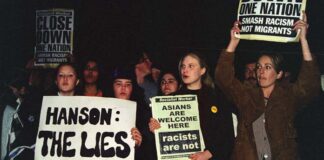Throughout the 2010 federal election, Tony Abbott and Scott Morrison proclaimed that, “We [ie the Coalition] stopped the boats before, we can stop the boats again.” But a closer look at the Pacific Solution shows that Abbott’s claim that “Howard stopped the boats” does not stand up to scrutiny.
It was a simplistic and, in effect, vicious slogan that went unchallenged by Labor or Julia Gillard. It could have been challenged both on factual grounds and on principled humanitarian grounds. But Gillard lacked the political will and the political courage.
Julia Gillard has relentlessly dragged Labor’s refugee policy further to the right as she races to outdo Tony Abbott’s anti-refugee policies. While Tony Abbott says Nauru will stop the boats, Julia Gillard and Chris Bowen now say the Malaysia Solution will stop the boats.
Immigration Minister Chris Bowen tries to dress up “stopping the boats” in humanitarian garb—as if he was really concerned about asylum seekers making dangerous boat journeys.
Even refugee supporter Robert Manne wrote in The Monthly in September 2010 that stopping the boats is necessary because public opinion has remained extremely hostile to boat arrivals since 2001, and increased boat arrivals would harden opinion further. Therefore, he argues, any realistic refugee policy can only be based on stopping the boats and resettling asylum seekers after some form of offshore processing in a revived Pacific Solution.
Abbott says that under the Howard Government, from 2002, boat arrivals averaged three a year. These figures come from the official statistics (see here for example).
Rigged statistics
But the official statistics are rigged. They don’t record the number of boats, or the number of asylum seekers on them, that were intercepted, towed back, turned around or foundered. Operation Relex, a naval interdiction program to intercept and/or turn asylum boats around, began on September 3, 2001.
There are various estimates for the number of asylum seekers diverted to Nauru or Manus Island during the years of the Pacific Solution, 2001 to 2007. The UNHCR estimates that 1600 ended up there. So at least 1600 people did attempt to come to Australia after the beginning of the Pacific Solution.
There may have been even more—DIMIA fact sheet No 76 (removed from its web site in 2005, but recorded in the book Future Seekers II) showed that 12 boats (including the Tampa), with 1820 people in total were stopped from getting to the mainland within less than a year between August 2001 and May 2002.
In addition there were other boats that tried to get to Australia but were turned around or sank. In 2001, four boats with at least 600 people were intercepted and returned to Indonesia.
In 2002, at least another four boats, SIEV 5, 7, 11 and 12 were returned to Indonesia while three boats (SIEV 4, 6 and 10) sank. In 2003, SIEV 14 attempted to make the voyage to Australia but was towed back, while a boat of 53 Vietnamese asylum seekers made it to the mainland at Darwin.
In 2002, another two boats attempted to sail from Indonesia to New Zealand (one foundered). In 2004 another boat also tried to get there.
The shocking sinking of the SIEV X in October 2001, that saw the loss of 353 mostly women and children, also had a dreadful impact at the time—particularly as it seemed either or both of the Indonesian and Australian navies may have known of the boat but turned a blind eye to the sinking.
‘Push factors’
So the boats didn’t stop. A statistical study on Crikey blog Possum Comitatus compares asylum seekers arriving in Australia by boat and global asylum numbers since 1994. It shows that the decline in the number of boats is better explained by “push factors”—the international decline in Afghan asylum seekers after the fall of the Taliban in Afghanistan in 2001, for example—than any deterrent effect of the Pacific Solution.
Comparing numbers from 38 developed countries where data exists it concludes that, “the relative patterns through time of boat arrivals in Australia, is itself a function of broader global asylum seeker trends”.
Boat arrivals to Australia have come in waves in response to the situation for asylum seekers in source countries. Refugees fled Vietnam in the 1970s following the Vietnam War, Cambodia in the early 1990s during a civil war, and Sino-Vietnamese came in the mid-1990s following a border conflict between the two countries.
More recently asylum seekers have arrived following the end of Sri Lanka’s civil war, in response to the crackdown on Iran’s democracy protests in 2009 and fleeing declining conditions in Afghanistan.
Chris Bowen bragged in The Australian that the Malaysia Solution, “…will have the same (or better) practical effect as turning back the boats”.
But as long as asylum seekers need protection, they will try to get to Australia. Howard didn’t stop the boats. Gillard won’t stop them either. We shouldn’t even let them even try.
By Ian Rintoul





